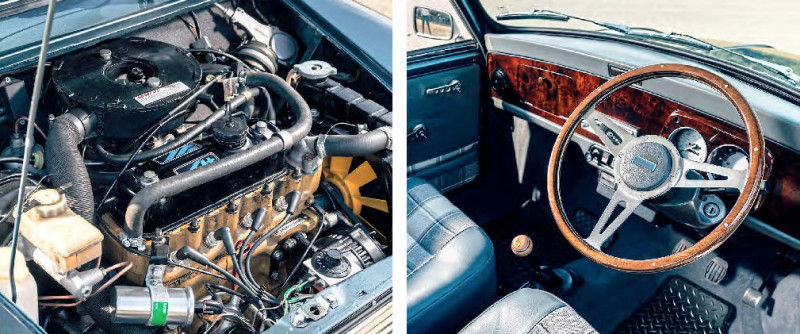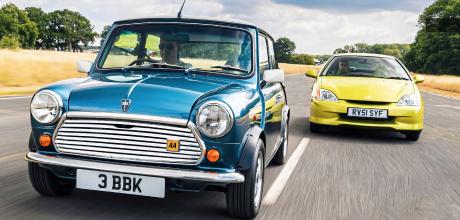1991 Rover Mini Neon
With its diminutive dimensions placing a wheel at each corner, the Mini became the blueprint for all the best city cars to come – though its breadth of talent always extended far beyond the ring road. Charm exudes from every facet of the Mini driving experience – proving as intoxicating for drivers of the late Fifties and early Sixties as for those half a century later. It’s frugal too, which makes it a suitable adversary for the Honda Insight. Both are small nimble cars able to zig-zag through bustling urban lanes, yet still enthral on an A road – all the while managing bus-fare beating running costs.
By the Eighties, the Mini’s mass market appeal was very much on the wane – helped in no small part by the arrival of its nearmechanically- identical successor, the Metro. Yet tooling costs that had long been covered meant it made financial sense to keep churning out Minis. It was perennially popular with cashstrapped drivers, and its low insurance group saw to it that new teenage drivers were also a steady trickle into showrooms – well, their parents armed with chequebooks (remember those?) were at least. The Nineties was a decade of reflection for the UK. As we looked back to past glory, the fashion, music and culture of the Sixties came to the fore. The Mini had been in production for so long it found itself back in fashion again.

Cash-strapped Rover only updated the Mini when absolutely necessary, but largely got away with it because there wasn’t a lot wrong with the formula in the first place. The A+ engine replaced the original A series, which had provided motive power from 1959 to 1983. By the time this special-edition Mini Neon arrived in 1991, visually there was still little to differentiate it from one of its siblings produced a decade earlier. Later that same year however, fuel injection and a catalytic converter would debut, alongside the welcome reintroduction of the Cooper S.
This Neon is just one of a host of special editions – to detail them all would take more pages than we have – though the recurring yarn with most was that their additions were largely cosmetic. The Neon is no different, receiving decals, badges and little else. Our example has had a few upgrades since leaving the factory but what Mini hasn’t? They’re limited to a retrim and some sporty alloy wheels – as standard the Neon got grey velour trim and Prestige full-width plastic wheel trims… Fancy.
No matter its year or model, reacquainting oneself with the Tardis-like confines of a Mini cabin is about as familiar as catching a Dad’s Army re-run. It provides a similar bygone-era charm too, which seems to drip from every exposed piece of metalwork or run of stitching – there’s a Mini smell too, subtle but evident. This is as basic as an interior gets but somehow doesn’t feel lacking; you have just what you need. The large central speedo of older Minis has moved to a dash cluster where it’s almost invisible to anyone over six-feet tall. Thankfully, you drive a Mini more on feel and sound than its dials anyway.
The engine in this Mini Neon is your standard 40bhp A+ fourcylinder, capable of getting us up to 80mph. Not that we’ll get there quickly with a 0-60mph time in the high teens. Somehow this Mini still feels sportier than the Insight, despite its 32bhp handicap – largely offset by a 210kg weight advantage. The engine sits in your lap, and isn’t remotely refined, yet short gearing makes the most of limited performance. You can dart about through tiny gaps in traffic while easily achieving 40mpg. The legend of the Mini’s handling prowess is well deserved; this one dispenses with corners with the mechanical equivalent of a shrug. There’s minimal roll as direction changes are achieved with an ease that can only come from a serious lack of mass.
They’re perennially popular for a reason so Mini values have always seemed at odds with the car’s original cheap and cheerful intended purpose. A Nineties example worth having will set you back £7000. You can find scruffy but MoT’d ones for less, of course, but a bad Mini will not only test your patience like very few other machines on four wheels, it will also cost twice what you have to put right. Rust is the clear-and-present danger – if the community is to be believed, the later Minis are actually even more prone than early ones. You should also be vigilant for any ECU issues, if you’re looking at an MPi or SPi fuel-injected Mini, because these can often cause problems that require expert knowledge to put right.
The very best low-mileage cars can crack £10k, but a figure between £5000 to £6500 should get you a very nice Mini you should only need to service and polish. Just remember to keep it garaged because even late Minis rust with astounding enthusiasm.
Owning a Rover Mini
Carl Taylor is only holding onto this limited edition Mini until 14-year-old son Henry is old enough to take over ownership. ‘Henry is really into his cars and loves anything retro, particular Minis. My father, Roger Taylor, has been a classic car restorer his entire life and even though now semi-retired, he bought this Mini during lockdown as a project to keep him occupied. He carried out a full body-off restoration. We’ve had it for almost a year and all that’s gone wrong in that time is the heater box leaked – one of the few parts Dad didn’t replace. On top of that cost we had a service and MoT in March for about £240. The only downside of ownership so far is that we are precious about driving it in the rain, so don’t use it as often as we’d want.’
TECHNICAL DATA 1991 Rover Mini Neon
- Engine 998cc, inline four-cylinder, single camshaft ohv, single SU HS4 carburettor
- Max Power 40bhp @ 5250rpm
- Max Torque 50lb ft @ 2500rpm
- Steering Rack and pinion
- Transmission Four-speed manual, front-wheel drive
- Suspension Front: independent, rubber cone springs with telescopic dampers with upper radius arms and lower control arms on subframe. Rear: independent via cantilevered trailing arms with pushrods and rubber springs and telescopic dampers, on subframe
- Brakes Servo dual circuit. Front: discs (solid). Rear: drums
- Performance Top speed: 80mph; 0-60mph: 17sec
- Weight 625kg (1378lb)
- Fuel consumption 41mpg
- Cost new £5330 (price for a Mini Sprite in 1992)
- CC Price Guide £2000-£6250


